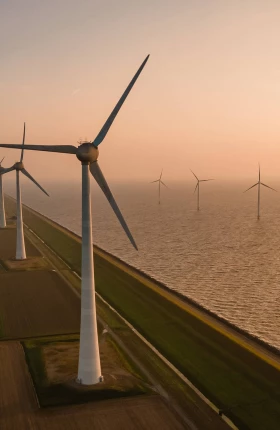By offering a suite of green products and services, banks can support the growing number of climate-conscious consumers—and reduce their own carbon footprints as well.
Consumer banks in Australia, the UK, and the US alone issued more than 15 million residential mortgages worth $4.5 trillion last year. Meanwhile, according to the UN, residential dwellings account for 17% of global energy-related emissions. Consumer banks, therefore, are indirectly responsible for a huge share of the greenhouse gas (GHG) emissions that cause global warming. And that’s before taking into account the auto loans and other financial products that consumer banks also typically offer their customers.
Consumer banks can contribute significantly to the fight against global warming while seizing a fast-growing business opportunity.
With consumers growing ever more conscious of their own carbon footprints, it’s time for banks to take responsibility for the emissions they underwrite. Compared with their institutional and commercial banking cousins, consumer banks are only just now beginning to measure and account for the so-called financed emissions associated with their loans and investments and devise new loan options and other products to help customers reduce their carbon footprint.
Consumer banks can contribute significantly to the fight against global warming while seizing a fast-growing business opportunity. Here’s how.
The Consumer Banking Gap
Governments around the world are encouraging banks to take a more active role in addressing climate change. The European Union, for example, plans to put in place climate-related reporting obligations during the next two years under its Sustainable Finance Disclosure Regulation. In the US, the Biden administration has issued an executive order intended to strengthen the financial system’s resilience to climate change. And the Chinese government has announced regulation to encourage banks to develop climate-friendly financial products.
The financial services industry is responding. As of August 2021, more than 70 of the world’s leading banks have committed to aligning their lending and investment portfolios with net-zero emissions by 2050. Until recently, however, the net-zero focus has been on corporate banking, capital markets, and asset management. Consumer banking is late to the party.
But the opportunity is there: In Oracle’s recent survey of around 2,500 consumers in Europe, North America, and the UK, more than half of respondents said that fighting climate change is personally important. Yet three-quarters also said they do not know where their carbon emissions come from.
Consumer banks are well placed to offer the information and products needed to support the growing number of customers who want to reduce their own personal climate impact.
Efforts to measure, report, and reduce the financed emissions of mortgages should be on every consumer bank’s agenda. We’ve identified a three-step process for consumer banks to take in order to proactively contribute to a lower-carbon world:
- Commit to addressing their climate impact and set relevant targets.
- Develop products and services that encourage customers to reduce emissions.
- Measure and report financed emissions and the progress made toward net zero.
Step 1: Commit to Addressing Climate Impact and Set Targets
While many financial institutions have pledged their commitment to a net zero future, few have translated their intentions into action. A 2020 CDP report that examined 332 financial institutions found that 49% did not conduct any analysis of their lending and investment portfolio’s climate impact, while 55% had not aligned their lending portfolios with a net-zero carbon world. Moreover, only 34 of the financial institutions disclosed their financed emissions, even though such emissions are, on average, 700 times larger than financial institutions’ direct operational emissions.
Consumer banks need to turn their net-zero commitments into concrete, actionable targets. For example, ING works with the sectors in its loan book that generate the most climate impact, including residential real estate, to ensure they are on a pathway aligned with the Paris Agreement. According to ING’s 2021 Climate Report, the company’s “vision is to have an energy-positive mortgage portfolio by 2050. This means that the houses in our portfolio will collectively generate more energy than they consume.” To achieve this, ING is making advice and financing options available to customers to improve the energy efficiency of their homes. And it is working with governments and other industry stakeholders to develop innovative solutions to reduce emissions from housing construction and use.
Step 2: Develop Products and Services That Encourage Customers to Reduce Emissions
Virtually every consumer bank today has at least one green banking product or service, but very few have a full suite of comprehensive green offerings. Banks will need to develop such a suite to support customers in their efforts to reduce their carbon footprints in every aspect of their banking lives. These green offerings should include mortgages; other personal financing, such as loans for energy efficiency upgrades and electric vehicles (EVs); emissions calculators; and investment products.
Mortgages. Banks can provide tools to assess the energy efficiency of homes that potential buyers are considering and the impact of that level of efficiency on financing and operating costs. Such assessments could be expanded to include an understanding of, for example, the travel costs and emissions associated with the location of the dwelling under consideration and its vulnerability to physical risks posed by such climate-related disasters as fire, flood, and other extreme weather events.
Some banks do currently offer green mortgages, which provide discounts on interest rates or fees to purchasers of energy-efficient dwellings. Others, however, are reluctant to do so given historically low take-up rates and the potential erosion of banks’ profit margins. The potential for socially inequitable loan programs also remains a concern, since wealthier households are typically the ones that can afford modern, energy-efficient properties.
By building energy and climate considerations into their own credit risk processes, banks can better manage the climate-related risks associated with their green mortgage portfolios.
By building energy and climate considerations into their own credit risk processes, banks can better manage the climate-related risks associated with their green mortgage portfolios.
Green mortgages are also being packaged into green bonds and mortgage-backed securities in the Australian, UK, and US markets. While these products are still relatively niche, they show significant growth potential. Last year, for example, Barclays raised a $545 million green bond to finance energy-efficient residential mortgages that was oversubscribed—by five times.
In addition, a considerable number of banks are offering products and services to customers to retrofit their existing dwellings. These include loans for energy efficiency upgrades, such as solar panels, thermal insulation, and double-pane windows and doors; connections to a network of approved energy efficiency advice and upgrade services; and rebates on qualified energy products and services.
Other Personal Financing. The shift to EVs has led more banks to offer relevant products and services to their customers, including advice on finding the right EV, loans for EVs, and subsidies for electric charging stations. Similar products and services could be developed for, and applied to, other major expenditures, such as buying boats or booking vacations.
Emissions Calculators. An increasing number of banks offer carbon calculators that use transaction data to estimate individual consumers’ emissions, compare their carbon footprints, and provide suggestions to reduce emissions. Banks can also help nudge consumers toward limiting or offsetting their emissions with such mechanisms as automated carbon spending cap warnings, which notify customers when their spending has exceeded a preset carbon footprint threshold. Carbon offsets could also be used instead of frequent-flier points, for example, as an option for loyalty rewards.
Investment Products. Consumer banks that offer investment-related products can help their customers understand the climate credentials of various investment options. Eligible customers could access wealth management and private bank services or receive personalized advice on how to reduce their carbon footprints.
Action. In general, banks need to consider where they can most effectively influence consumer behavior for the good of the customer, the bank, and the planet. This will differ for each bank, given its unique geographic footprint, customer base, and range of consumer banking offerings. Banks could also consider taking action in other areas that involve environmental and social factors, such as financial inclusiveness and the circular economy.
Step 3: Measure and Report
In light of the Paris Agreement, multiple alliances, organizations, and governments—including the European Union, NGFS, and the Taskforce for Climate-Related Financial Disclosures—are urging financial institutions to increase transparency, enhance their climate-related reporting, and take stronger action.
In a BCG global review of 90 banks in June 2021, however, only 12 were measuring and reporting the financed emissions attributable to their home loan portfolios. That’s a problem, given that energy use typically contributes approximately 55% to 80% of a building’s total lifecycle emissions.
Some banks already measure and report home loan emissions, including National Australia Bank; ING, ABN AMRO, and Achmea in the Netherlands; and National Westminster Bank and Lloyds Bank in the UK. While they all adhere to the standard set by the Partnership for Carbon Accounting Financials, the accuracy of measurement varies. For example, Dutch banks can report financed emissions reasonably accurately because energy efficiency ratings are available for almost every dwelling in the country; in the UK, however, such ratings are available for only about half of all properties. In Australia, banks currently use statewide energy efficiency averages because of a lack of information about individual homes. To the best of our knowledge, no banks in the US currently report their financed emissions.
Using an average of local energy usage or relying on the energy rating for each building, however, fails to capture the considerable differences in individual energy usage among households and the resulting emissions. It also tends to be static: even if a dwelling becomes more energy efficient, its energy rating may be updated only when it is sold or rented. Enhanced methods—such as measuring actual energy use through the use of smart meters, for example—would provide greater comparability within and across markets and help banks to track progress in emissions reduction over time.
Most banks that report financed emissions use absolute metrics, such as total kilograms of carbon dioxide equivalent (CO2e) emitted, as well as per-unit metrics, such as kilograms of CO2e per square meter of property or tons of CO2e per $1 million invested. Per-unit metrics enhance comparability over time and across markets.
In time, measuring financed emissions will become an integral part of interactions between consumers and their banks, so all banks should seek to be ready with access to actual data that is continuously updated in real time.
Banks looking to improve how they measure and report financed emissions should consider how their reports can help consumers understand the emissions associated with residential properties, and, over time, enhance their reporting with the following categories of data:
- Actual energy use
- Relevant emissions from construction, materials, land clearing, and demolitions
- Data on other types of consumption to help customers reduce their overall carbon footprints
Toward a Net-Zero Future
The need for climate action is critical across all areas of the global economy. Consumer banks can make a valuable contribution to reaching net zero—and gain market share by doing so.
To be successful, banks will need to capture and analyze customer emissions data much as they gather and use financial data today. This will require partnering with other organizations—such as with major retailers to estimate the emissions from purchases, with car manufacturers to compare emissions data for different models, and with utility companies to share actual energy usage data for measuring household-level energy emissions.
Consumer banks have an opportunity to provide customers with a green option for every product and service as well as to give them the information and tools needed to make more informed decisions about their own carbon footprints. How better to underwrite the journey to a net-zero future?
The authors would like to thank Tony Chen and Eliza Spring for their contributions to this article.






